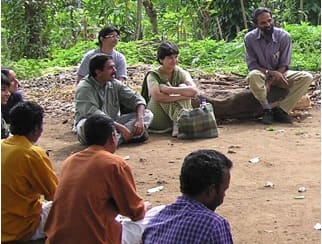
Indigenous peoples
In the words of a representative of a federation of indigenous peoples Member of the ICCA Consortium: “Indigenous peoples live in nearly all countries on all continents of the world and form a spectrum of humanity, ranging from traditional hunter-gatherers and subsistence farmers to legal scholars. Indigenous peoples number between 300-500 million, embody and nurture 80% of the world’s cultural and biological diversity, and occupy 20% of the world’s land surface”.[1]
Descriptions in UN websites are similarly broad: “Indigenous peoples are inheritors and practitioners of unique cultures and ways of relating to people and the environment. They have retained social, cultural, economic and political characteristics that are distinct from those of the dominant societies in which they live”.[2] A precise estimate of the number of indigenous peoples alive today is, thus, rather problematic.
In 1986, the United Nations Commissioner on Human Rights[3] proposed to identify indigenous peoples as peoples having “historical continuity with pre-invasion and pre-colonial societies that developed on their territories”. Following the 1989 International Labour Organization Convention No. 169, Concerning Indigenous and Tribal Peoples, the ‘time factor’ has been further emphasized and indigenous peoples have been noted as traditional peoples “who hold an unwritten corpus of long-standing customs, beliefs, rituals and practices that have been handed down from previous generations”.[4]
The 2007 UN Declaration on the Rights of Indigenous Peoples (UNDRIP) suggests a set of guiding characteristics that may assist in the identification of indigenous peoples, which include: self-identification as indigenous nations and/or peoples;a shared history of suffering injustices, colonization and land dispossession; a complex web of place-based relationships; language, traditional practices, knowledge, and legal and cultural institutions distinct from those dominant in the national state where they reside;[5] and knowledge, culture and practices that contribute to sustainable governance and management of human relationships with the natural world and beyond.
Additionally, some stress the following characteristics as clear indicators of indigeneity: “having preserved the customs and traditions of their ancestors which are similar to those characterized as indigenous” and “being, even if only formally, placed under a state structure which incorporates national, social and cultural characteristics alien to their own”.[6]
UNDRIP refers to indigenous peoples (versus people singular), since peoples are recognized as subjects of international law, whose collective right to self-determination are upheld by two International Covenants of 1966 — the one on Civil and on Political Rightsand the one on Economic, Social and Cultural Rights. Regardless of the international recognition of their collective rights, at the national level, not all indigenous peoples are today recognised as holders of collective rights to land and natural resources (see #Collective rights).
Cases of over/under-inclusiveness
The Philippines
The definitions of indigenous peoples listed above include a range of criteria for inclusion or exclusion, which may result in over/under-inclusion. Under a definition solely based on link to pre-colonial societies, all the people living in colonized countries would be considered indigenous (apart from immigrants or those who are the direct descendants of the colonizers). For example, in the Philippines, all Filipinos would be indigenous since they are “existing descendants of the peoples who inhabited the present territory”.[7]
However, colonisation led many Filipinos to abandon their cultural traditions, become disconnected from their territories of life and part of a majority population that can even be insensitive toward indigenous minorities… This is not, however, the case for many Igorots of the Cordillera and Lumad of Mindanao. Unlike most of the rest of the Philippines’ population, the Igorot have “preserved intact the customs and traditions of their ancestors”[8] and, in fact, according to Reyes (2017): “such peoples are the groups generally entitled to specific rights of indigenous peoples under international law”.[9]
Nepal
Contextual factors are especially important in order to distinguish the indigenous versus non-indigenous population. James Anaya, former Special Rapporteur on the Rights of Indigenous Peoples, noted that “it is difficult to divide the population of Nepal into indigenous versus non-indigenous sectors if the term ‘indigenous’ is taken in a general sense and without regard to certain contextual factors”.
Nepal, for example, does not have a past of colonization by foreign power, hence either all or no part of the population, regardless of their strong sense of connection and belonging to their land, may be formally identifiable as indigenous. Yet, Anaya identified the Adivasi Janajati, unlike the majority of other Nepali people, as indigenous peoples on grounds of their self-identification, historical exclusion from the dominant social and religious hierarchy, and distinct language and traditional customs. [10]
The ICCA Consortium emphasizes self-identification as a necessary element of indigenous identity and recommends referring to indigenous peoples by their self-designated nation name.
Key references:
United Nations Commission on Human Rights, 1986; Mugabe, 1998; Corntassel, 2003; Niezen, 2003; UNDRIP, 2007; Reyes, 2017; Carino and Tamayo, 2019.
See also: IWGIA International Working Group for Indigenous Affairs; United Nations website on indigenous peoples; Indigenous navigator.
Notes:
[1] Reyes, 2017. The figures quoted by Reyes are reported by several other authors. It is difficult, however, to trace them back to robust analyses beyond the claims made by Sobrevila (2008, page 5 and 50), which refers to WRI (2005) where the supposed backing cannot be traced. The ICCA Consortium has no reason to believe that the figure quoted is incorrect, but it suggests referring to the work of Alden Wily (2011) and Garnett et al. (2018) to corroborate it. For what regards cultural diversity, the reference to Sobrevila (2008, page 3 and 52) is similarly clear but scarcely referenced (Sobrevila actually speaks of 95% of cultural diversity being represented by the 5000 ethnic groups that represent only 4 percent of the world population).
[2] United Nations website on indigenous peoples, https://www.un.org/development/desa/indigenouspeoples/about-us.html.
[3] In its 1986 Study of the Problem of Discrimination Against Indigenous Populations.
[4] Mugabe, 1998.
[5] This notwithstanding the fact that in some countries (like Papua New Guinea and Bolivia) indigenous peoples constitute the majority of the population (Reyes, 2017).
[6] Reyes, 2017.
[7] Reid, 2009.
[8] Ibid.
[9] Reyes, 2017.
[10] Anaya, 2009.